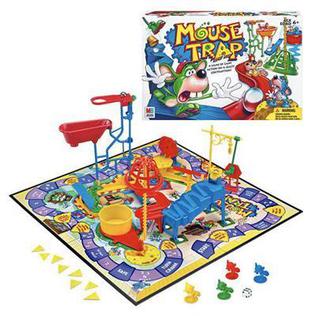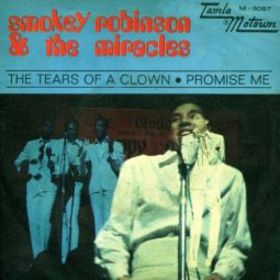
Cracker Jack is an American brand of snack food that consists of molasses-flavored, caramel-coated popcorn, and peanuts, well known for being packaged with a prize of trivial value inside. The Cracker Jack name and slogan, "The More You Eat The More You Want", were registered in 1896. Food author Andrew F. Smith has called it the first junk food.
Mr. Potato Head is an American toy brand produced by Hasbro since 1952. It consists of a plastic model of a potato "head" to which a variety of plastic parts can attach — typically ears, eyes, shoes, hat, nose, pants and mouth.
"Pop! Goes the Weasel" is a traditional English and American song, a country dance, nursery rhyme, and singing game that emerged in the mid-19th century. It is commonly used in jack-in-the-box toys and for ice cream trucks.

Mouse Trap is a board game first published by Ideal in 1963 for two to four players. It is one of the first mass-produced three-dimensional board games. Players at first cooperate to build a working mouse trap in the style of a Rube Goldberg machine. Then, players turn against each other to trap opponents' mouse-shaped game pieces.
McFarlane Toys is an American company founded by comic book creator Todd McFarlane which makes highly detailed model action figures of characters from films, comics, popular music, video games and various sporting genres. The company, a subsidiary of Todd McFarlane Productions, Inc., is headquartered in Tempe, Arizona.

"The Tears of a Clown" is a song written by Hank Cosby, Smokey Robinson, and Stevie Wonder and originally recorded by Smokey Robinson & the Miracles for the Tamla Records label subsidiary of Motown, first appearing on the 1967 album Make It Happen. The track was re-released in the United Kingdom as a single in July 1970, and it became a number-one hit on the UK Singles Chart for the week ending September 12, 1970. Subsequently, Motown released a partially re-recorded and completely remixed version as a single in the United States as well, where it quickly became a number-one hit on both the Billboard Hot 100 and R&B Singles charts.
"The Steadfast Tin Soldier" is a literary fairy tale by Hans Christian Andersen about a tin soldier's love for a paper ballerina. The tale was first published in Copenhagen by C.A. Reitzel on 2 October 1838 in the first booklet of Fairy Tales Told for Children. New Collection. The booklet consists of Andersen's "The Daisy" and "The Wild Swans". The tale was Andersen's first not based upon a folk tale or a literary model. "The Steadfast Tin Soldier" has been adapted to various media including ballet and animated film.

"A Lover's Concerto" is a pop song written by American songwriters Sandy Linzer and Denny Randell, based on the 18th century composition by Christian Petzold, "Minuet in G major", and recorded in 1965 by the Toys. "A Lover's Concerto" sold more than two million copies and was awarded gold record certification by the RIAA.

The Life and Adventures of Santa Claus is a 1902 children's book, written by L. Frank Baum and illustrated by Mary Cowles Clark.

Motion pictures featuring Santa Claus constitute their own subgenre of the Christmas film genre. Early films of Santa revolve around similar simple plots of Santa's Christmas Eve visit to children. In 1897, in a short film called Santa Claus Filling Stockings, Santa Claus is simply filling stockings from his pack of toys. Another film called Santa Claus and the Children was made in 1898. A year later, a film directed by George Albert Smith titled Santa Claus was created. In this picture, Santa Claus enters the room from the fireplace and proceeds to trim the tree. He then fills the stockings that were previously hung on the mantle by the children. After walking backward and surveying his work, he suddenly darts at the fireplace and disappears up the chimney.

Santa Claus is a 1959 Mexican fantasy film directed by René Cardona and co-written with Adolfo Torres Portillo. In the film, Santa Claus works in outer space and battles with a demon named Pitch, sent to Earth by Lucifer to ruin Christmas by killing Santa and "making all the children of the Earth do evil".

A pop-pop boat is a toy with a simple steam engine without moving parts, typically powered by a candle or vegetable oil burner. The name comes from the noise made by some versions of the boats.

Funko Inc. is an American company that manufactures licensed and limited pop culture collectibles, best known for its licensed vinyl figurines and bobbleheads. In addition, the company produces licensed plush, action figures, apparel, accessories and games. Founded in 1998 by Mike Becker and Claudia Becker, Funko was originally conceived as a small project to create various low-tech, nostalgia-themed toys. The company's first manufactured bobblehead was of the Big Boy restaurant mascot.
The Toy Castle is a Canadian children's television show that aired on Treehouse TV, SCN, Access, Knowledge Network, TVOntario and TFO. It was aired from September 4, 2000 to December 26, 2003 and produced by Sound Venture Productions. It was inspired by Sound Venture's 1992 Christmas ballet special The Tin Soldier, which starred Frank Augustyn and was based on Hans Christian Andersen's fairy tale. It is now shown during the Christmas season on Treehouse, TFO and Noovo. Told through ballet and narration, the stories are about a group of toys in a toy castle that magically come to life when the children are asleep. This series won a Gemini Award in 2003 for "Best Preschool Series".
Midnight in a Toy Shop is an American 1930 Silly Symphonies animated short film directed by Wilfred Jackson and produced by Walt Disney Productions.

Toy Story Land is a themed land at Walt Disney Studios Park, Hong Kong Disneyland, Shanghai Disneyland, and Disney's Hollywood Studios. The area is based on the Disney·Pixar film series Toy Story.
Prizes are promotional items—small toys, games, trading cards, collectables, and other small items of nominal value—found in packages of brand-name retail products that are included in the price of the product with the intent to boost sales, similar to toys in kid's meals. Collectable prizes produced in series are used extensively—as a loyalty marketing program—in food, drink, and other retail products to increase sales through repeat purchases from collectors. Prizes have been distributed through bread, candy, cereal, cheese, chips, crackers, laundry detergent, margarine, popcorn, and soft drinks. The types of prizes have included comics, fortunes, jokes, key rings, magic tricks, models, pin-back buttons, plastic mini-spoons, puzzles, riddles, stickers, temporary tattoos, tazos, trade cards, trading cards, and small toys. Prizes are sometimes referred to as "in-pack" premiums, although historically the word "premium" has been used to denote an item that is not packaged with the product and requires a proof of purchase and/or a small additional payment to cover shipping and/or handling charges.

The Clock Watcher is a 1945 American animated short film produced by Walt Disney Productions and released by RKO Radio Pictures. The cartoon follows Donald Duck as he works at the Royal Bros. department store, where he goofs off by breaking gifts and wrapping them poorly.

"Toy" is a song recorded by Israeli singer Netta Barzilai. Written by Doron Medalie and the song's producer Stav Beger, the song was released on 11 March 2018 along with its official music video clip, which was directed by Keren Hochma. It is best known as Israel's winning entry at the Eurovision Song Contest 2018 held in Lisbon, Portugal. The song was leaked online a day before the official release.













